Sechelt, BC V0N 3A0
Canada
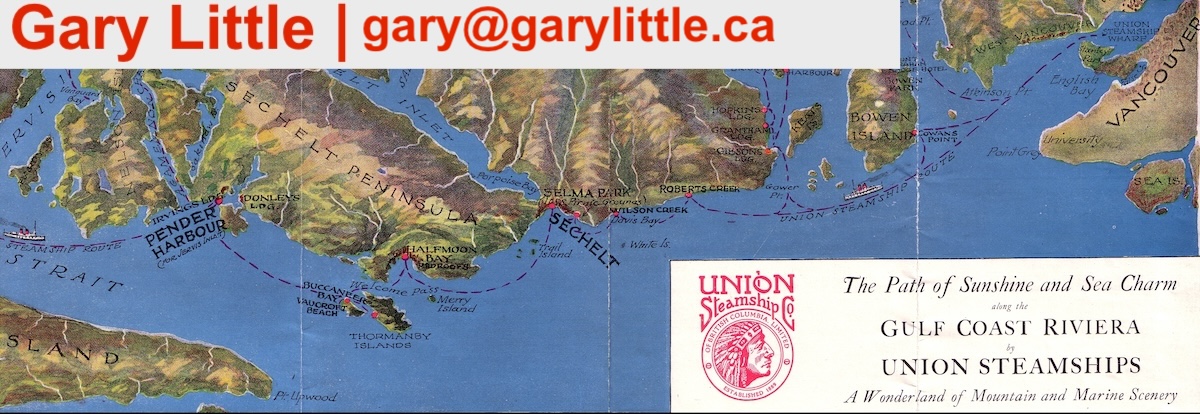
|
#201 - 5760 Teredo St
Sechelt, BC V0N 3A0 Canada |

|
|
Union Steamship Company 1889-1959:
Opening Up the Sunshine Coast SECHELT, BC — November 4, 2008 — Local real estate agent Gary Little has written the following article relating to the history of the Union Steamship Company, a maritime firm which played an important role in the early development of the Sunshine Coast as a commercial and tourism centre. This is one in a planned series of articles on the history of B.C. to celebrate the sesquicentennial of the founding of the Crown Colony of British Columbia in 1858. In 1889, the Union Steamship Company of British Columbia Ltd. (USSCo) was formed to provide maritime transportation services for the benefit of the two or three thousand loggers, fisherman, farmers, and other hardy residents of the Sunshine Coast and dozens of other small communities scattered along the British Columbia north coast. Its ships carried passengers, freight, and mail to and from the Union Dock located at the foot of Carrall Street in the Gastown area of the newly incorporated city of Vancouver.
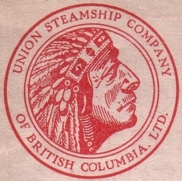
An early USSCo logo 
The USSCo flag USSCo also promoted the area as an idyllic tourist destination: it was referred to as the Gulf Coast Riviera in colourful travel brochures and thousands of people visited over the years to enjoy a wide range of outdoor recreational activities.
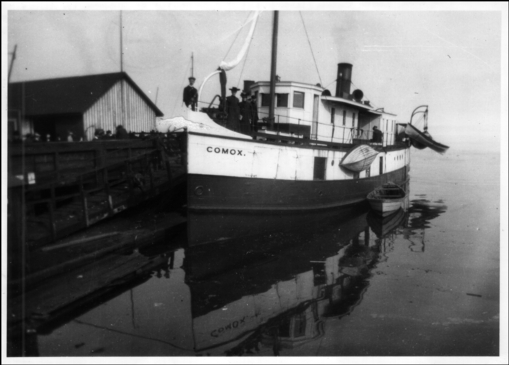
The S.S. Comox regularly served the Sunshine Coast from 1891 to 1917 (Courtesy of the Vancouver Maritime Museum) Over the years, many wharves were built along the coast so that the USSCo ships could load and unload passengers, the mail, and other cargo more easily. There were wharves located at Hopkins Landing, Granthams Landing, Gibsons Landing, Roberts Creek, Davis Bay (then called the Wilson Creek wharf), Selma Park, Sechelt, Halfmoon Bay, and Irvines Landing.
In 1917 the Comox was replaced by the Chilco (renamed Lady Pam in 1935) and Chasina which had been acquired that year from the rival All Red Line. The Capilano II also began serving the Sunshine Coast in 1920.
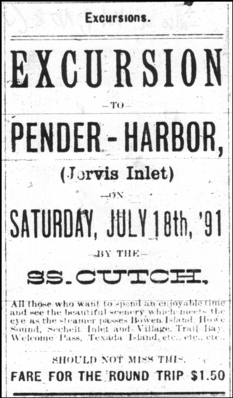
Advertisement for an excursion aboard the S.S. Cutch to "Pender-Harbor" in the summer of 1891 All those who want to spend an enjoyable time and see the beautiful scenery which meets the eye as the steamer passes Bowen Island, Howe Sound, Sechelt Inlet and Village, Trail Bay, Welcome Pass, Texada Island, etc., etc., etc., SHOULD NOT MISS THIS. The fare for the round trip was only $1.50 and the cruise took about 4 1/2 hours each way. This first excursion was a huge success. The Daily News-Advertiser gushed:
A most enjoyable day was spent by the 250 people who took the good steamer Cutch yesterday morning for Pender Harbor. With the exception of a ten-minute shower, the weather was delightful, and scarcely any place could be more naturally adapted for holidaying than this beautiful water which has the distinction of being the first land locked harbor on the Mainland, north of Vancouver, deep enough for ocean vessels. Lunch was first taken on the point where the party landed, and that finished, the visitors dispersed to explore the different arms of the harbor, to visit the pretty lake to the eastward of the landing, to fish, to bathe, and to enjoy themselves as their inclinations lead. Mrs. Kingcombe won the distinction of being the first lady to visit the lake, and in consequence Mr. A.E. Brown, the owner of the property, gave it the name of Kingcombe Lake [now called Hotel Lake]. The ship was taken again at 7 o'clock, and after a delightful journey in the fine moonlight night, home was reached at 11:30 o'clock. Pender Harbor seems bound to become a favorite holiday resort for pleasure seekers and sportsmen.
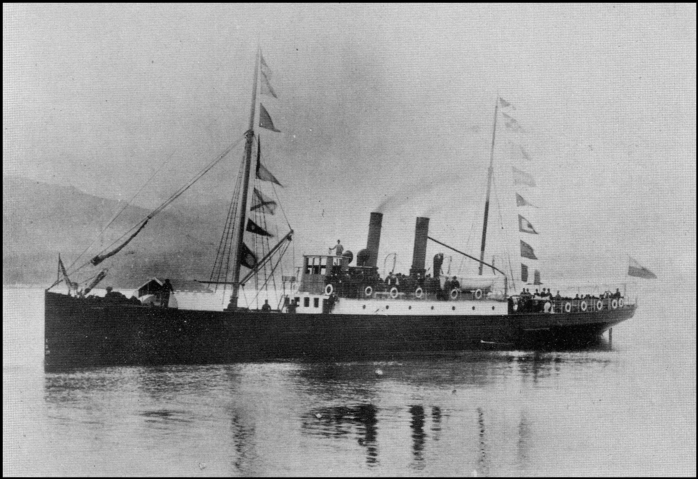
USSCo's first ship, the S.S. Cutch, in full regalia for a weekend excursion in 1891
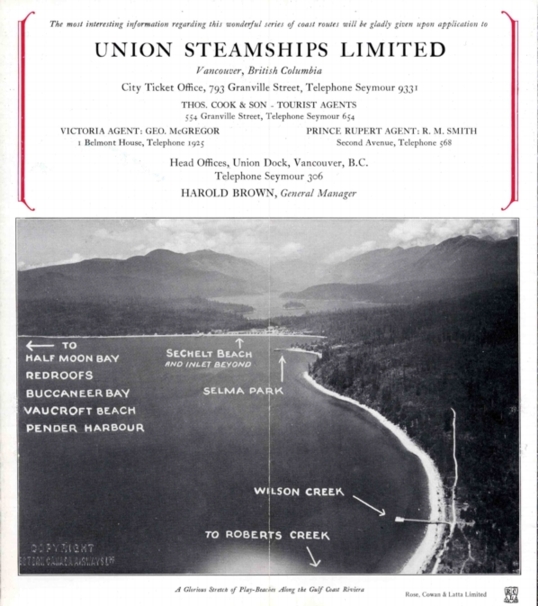
Aerial photo (ca. 1926) showing the "Play-Beaches Along the Gulf Coast Riviera" (Courtesy of the Sunshine Coast Museum & Archives) One popular tourist destination was a 7-acre parcel of land at Selma Park — only a 3-hour steamer trip from Vancouver — which USSCo had purchased when it acquired the All Red Line business in 1917. People flocked to this resort for swimming, sunbathing, hiking, fishing, picnicking, and tennis. A large dance pavilion with a magnificent view was also built on the heights across the road from the wharf and visitors could stay in cottage bungalows, camp cottages, or tents.
The price for a return trip to Selma Park in the early 1920s: $1.50 plus an extra 50 cents for lunch at the nearby Sechelt Hotel run by local mogul Bert Whitaker. In 1926, USSCo acquired Whitaker's businesses and land holdings in the village of Sechelt, including the hotel, general store, and wharf at Trail Bay.
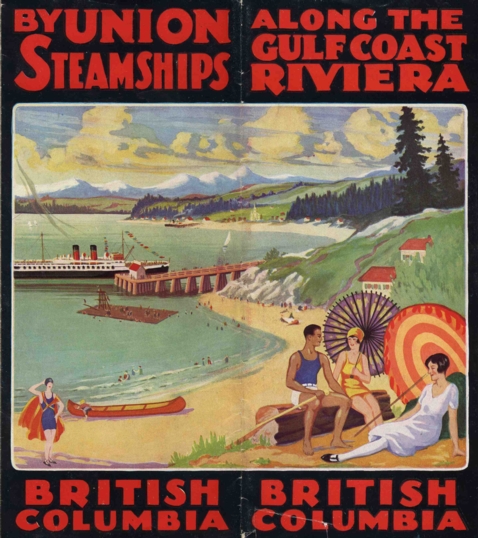
USSCo brochure (ca. 1926) showing the Selma Park wharf with Sechelt beach in the background (Courtesy of the Sunshine Coast Museum & Archives) USSCo launched several of its "Lady" ships in the mid 1920s to accommodate its booming excursion and day-boat business: Lady Evelyn (1923), Lady Alexandra (1924), Lady Cynthia (1925), and Lady Cecilia (1925). They were nicknamed the "Daddy Boats" because every Friday in the summer they were loaded with working men from Vancouver coming to visit their vacationing families.
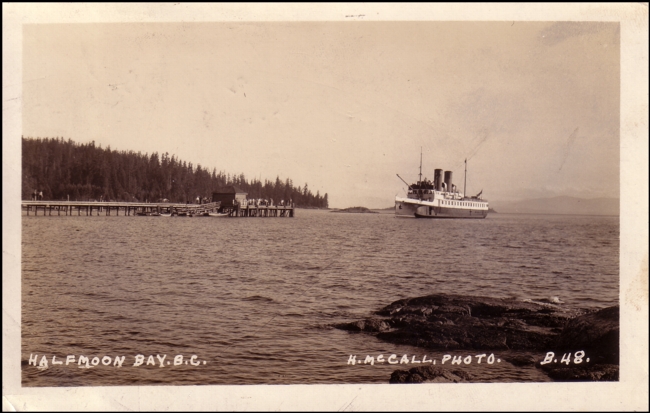
The Lady Cecilia arriving at the Halfmoon Bay wharf in the 1930s
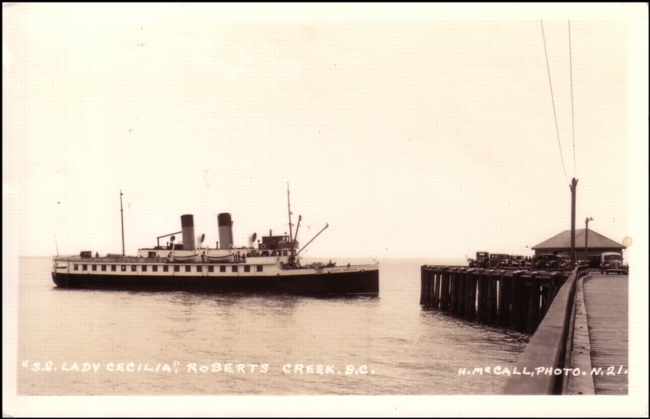
The Lady Cecilia arriving at the Roberts Creek wharf in the 1920s By the late 1940s, USSCo's tourism and commercial operations began to suffer. On the tourism side, the popularity of the automobile and a better road network meant that more and more people headed to highways rather than ships when they went on vacation. On the commercial side, remote communities and camps came to favour private boats or the convenience and speed of float planes for transportation. The Sunshine Coast's reliance on USSCo disappeared virtually overnight with the arrival of Black Ball Ferries' drive-on drive-off car ferry service between Horseshoe Bay and Gibsons in 1951 combined with the paving of the road to Sechelt in 1952. In early 1959, after 70 years of continuous service, USSCo ceased steamship operations completely: the Union Steamship era was over.

A USSCo map from a mid-1920s tourism brochure showing the Sunshine Coast route — "The Path of Sunshine and Sea Charm along the Gulf Coast Riviera by Union Steamships" (Courtesy of the Sechelt Community Archives) Gary Little is a realtor® and licensed real estate trading services representative in the offices of Royal LePage Sussex in Sechelt, British Columbia, Canada. He is a former senior software marketing manager, having previously worked in Silicon Valley for almost 20 years at the worldwide headquarters of Apple Inc. and Sun Microsystems, Inc. He is well known for his interactive real estate map of the Sunshine Coast (map.garylittle.ca).
This news release is located online at: http://www.GaryLittle.ca/history/union.html |